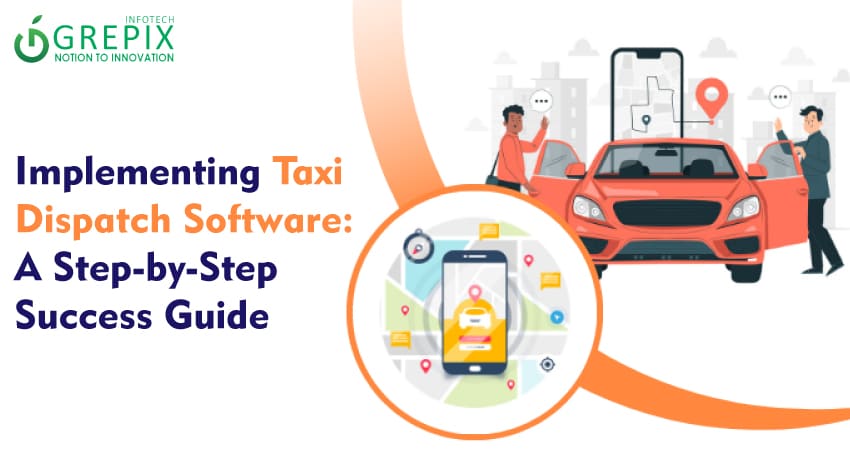Implementing Taxi Dispatch Software: A Step-by-Step Success Guide
In today’s fast-paced world, taxi services are not just a convenience but a necessity. For taxi business owners, staying competitive means leveraging technology to enhance operational efficiency and customer satisfaction. Taxi dispatch software is at the heart of this technological revolution, streamlining operations and offering customers easy booking options. Implementing such software, however, is a meticulous process that requires careful planning and execution.
The app development industry is revolutionizing numerous sectors with the increasing necessity for mobile applications. According to Statista, by 2023, mobile applications are projected to generate global revenues exceeding $995 billion. This marks a significant increase from the $585 billion in revenues recorded in 2020.
This guide provides a comprehensive overview of the steps involved in successfully implementing taxi dispatch software, ensuring your business can thrive in the modern transportation landscape.
This comprehensive guide details the process of implementing taxi dispatch software, crucial for enhancing operational efficiency and customer satisfaction in taxi services. It covers initial planning, including assessing business needs and software selection, to hardware upgrades and system integration. Key steps also include training for staff, rigorous testing of the software, and a phased rollout. Post-launch, continuous monitoring and iterative improvements ensure the system meets business demands. This strategic approach not only streamlines operations but also positions taxi businesses for future success in a competitive market.
How to Create taxi Dispatch Software
Creating taxi dispatch software involves several key steps, from initial planning and analysis through to development, testing, and deployment. Here’s a detailed guide to help you understand and navigate the process:
Also Read: "Why iPhone App Development is Crucial for Business Growth"
Step 1: Assess Your Business Needs
The first step in implementing any new technology is to assess your specific business needs. Understanding what you need from taxi dispatch software is crucial. Consider the following questions:
- How many vehicles are in your fleet?
- What are the common challenges your drivers face?
- What do your customers expect in terms of booking and payment options?
- Are there any particular regulatory requirements you need to comply with?
Answering these questions will help you outline the features you need in your software, such as GPS tracking, mobile app compatibility, automated dispatching, real-time updates, and payment processing capabilities.
Step 2: Market Research and Software Selection
Once you know what you need, the next step is to research and select the right software. Look for software that aligns with your business size, needs, and budget. It's important to compare different software providers, check reviews, and request demos. Key features to consider include:
- Ease of use: The interface should be intuitive for both your dispatchers and drivers.
- Scalability: The software should grow with your business.
- Integration capabilities: It should integrate smoothly with other tools you use, such as your CRM system or accounting software.
- Support and training: Ensure the provider offers adequate support and training resources.
Step 3: Infrastructure and Hardware Requirements
Implementing taxi dispatch software may require specific hardware or infrastructure upgrades, such as installing GPS devices in vehicles or setting up mobile data terminals. Evaluate your current technology stack and determine what needs to be upgraded or replaced. This step may involve:
- Upgrading your internet connection to ensure it can handle the new system.
- Purchasing smartphones or tablets for drivers if the dispatch system has a mobile app.
- Setting up secure, reliable data storage solutions for collecting and managing data generated by the dispatch software.
Step 4: Software Customization and Integration
Customizing the software to fit your specific operational workflow and integrating it with your existing systems is crucial. This might include:
- Customizing the user interface to match your brand and make it intuitive for your users.
- Integrating with your CRM to ensure that customer information and interaction are seamlessly connected.
- Connecting with accounting software to automate billing and invoicing processes.
Working closely with the software provider during this phase can help address any specific requirements or challenges your business might have.
Step 5: Training Your Team
Training is essential to ensure that your team is comfortable and proficient with the new taxi dispatch software. The training should cover all features of the software that your staff will use, including dispatchers, drivers, and administrative personnel. Effective training strategies include:
- Hands-on training sessions to allow users to experience the software under guided supervision.
- Creating comprehensive user guides and quick-reference materials.
- Setting up a support hotline or chat service for ongoing questions and issues that may arise during the initial stages of implementation.
Step 6: Testing the System
Before going live, it’s crucial to thoroughly test the software to ensure it functions as expected under real-world operating conditions. This involves:
- Simulating real dispatch scenarios to see how the software manages booking, dispatching, and tracking.
- Checking the integration points with other software to ensure information flows correctly.
- Testing the mobile app functionality in different locations to verify GPS accuracy and mobile data updates.
Step 7: Going Live
Rolling out the software is a critical phase where planning and preparation pay off. Start with a phased approach, perhaps by initially deploying the software to a limited number of vehicles or during off-peak hours. Monitor the software’s performance and gather feedback from both drivers and customers during this phase.
Step 8: Post-Implementation Review and Iterative Improvement
After going live, it’s important to continuously monitor the system and gather feedback. This allows you to:
- Identify any issues that weren't apparent during testing.
- Collect suggestions from users that could make the software more effective.
- Implement improvements in an iterative fashion, enhancing both user experience and operational efficiency.
Conclusion
In conclusion, as a leading taxi app development company, we understand that implementing taxi dispatch software is not just about adopting new technology—it's about transforming your business to meet the demands of the modern world. Our step-by-step guide is designed to help you navigate this transformation with ease and confidence. From assessing your specific needs to selecting the right software, and from training your team to going live, each step is crucial for a successful implementation.
We believe that by following this guide, your taxi service will not only increase its operational efficiency but also enhance customer satisfaction and competitive edge. Remember, the journey doesn't end with the launch. Ongoing evaluation and adaptation are key to staying ahead in the dynamic transportation sector. Our commitment to supporting you through every phase ensures that your investment in taxi dispatch software brings maximum returns.
Embrace the future of taxi dispatching with us, and let's drive your business forward together.
Looking out to start your own venture like Uber? Try out our HireMe Taxi Uber Clone, the easiest way to kick-start your taxi business.
FAQ'S
1. What are the primary benefits of implementing taxi dispatch software?
Taxi dispatch software enhances operational efficiency, improves customer satisfaction through easy booking and payment options, and provides real-time updates and GPS tracking to manage the fleet effectively.
2. How do I choose the right taxi dispatch software for my business?
Consider factors such as the size of your fleet, specific features needed (e.g., GPS, mobile compatibility, payment processing), ease of use, scalability, integration capabilities with other tools, and the level of customer support provided.
3. What kind of training is required for staff when implementing new dispatch software?
Comprehensive training for all users, including dispatchers, drivers, and administrative staff, is crucial. This can include hands-on sessions, creation of user guides, and access to a support hotline or chat service for ongoing assistance.
4. How should I test the taxi dispatch software before going live?
Conduct thorough testing by simulating real dispatch scenarios, checking integration points with other software, and ensuring the mobile app functions well in various locations to verify GPS accuracy and data updates.
5. What steps should be taken after the software goes live?
After going live, continuously monitor the system’s performance, gather user feedback, and make iterative improvements to address any issues and enhance functionality. This helps in fine-tuning the system to better meet the needs of your business and customers.








